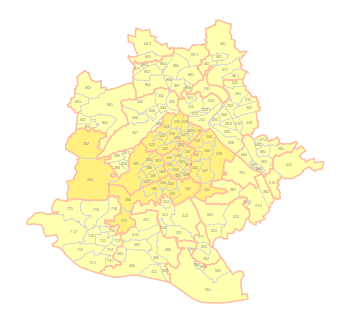Stuttgart
![]()
This article is about the capital of the state of Baden-Württemberg. For other meanings, see Stuttgart (disambiguation).
Stuttgart (Swabian: Schduegerd; original meaning: Stutengarten) is the capital of the German state of Baden-Württemberg and its largest city, with 630,305 inhabitants (31 December 2020). The sixth-largest city in Germany, it forms the centre of the Stuttgart region, one of Germany's largest metropolitan areas, with a population of around 2.8 million. It is also the core city of the European metropolitan region of Stuttgart (about 5.3 million inhabitants), the fifth largest in Germany. Stuttgart has the status of a city district and is divided into 23 city districts. As the seat of the state government and the state parliament of Baden-Württemberg, as well as numerous state authorities, Stuttgart is the political centre of the state. It is the seat of the Stuttgart Regional Council, which administers the administrative district of the same name. The regional parliament of the Stuttgart Region, one of the three regions in the Stuttgart administrative district, meets in Stuttgart. Stuttgart is also the seat of the Protestant Bishop of Württemberg and part of the Catholic Diocese of Rottenburg-Stuttgart. The city is an important business location and financial centre. It is known as the home of the German automobile companies Daimler and Porsche, on the other hand for the most frequent exceeding of the fine dust limit in Germany and the most congested German conurbation.
Stuttgart's cityscape is characterized by many hills, some of them vineyards, valleys such as the Stuttgart basin and the Neckar valley, green spaces such as Rosensteinpark, Schlossgarten, Höhenpark, as well as dense urban development with a high proportion of post-war buildings, various monuments, churches and some high-rise buildings.

Typical hilly cityscape at the Stuttgart valley basin: View of the Karlshöhe

Stuttgart castle square in the morning
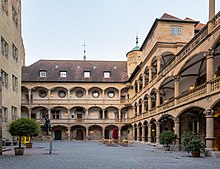
Arcade Courtyard in the Old Castle

The logo of the state capital Stuttgart used for public relations purposes
Geographical position
Stuttgart (in the local Swabian dialect Schduagerd) is located in the centre of the state of Baden-Württemberg. The core city is located "between forest and vineyards" in the "Stuttgart basin", a basin through which the Nesenbach, flowing north-eastwards towards the Neckar, and its tributary streams, especially the Vogelsangbach, flow. The city districts extend in the north to the Neckar basin, in the west to the Glemswald and the Gäu, in the east to the foothills of the Schurwald and in the south to the Filder plain and the foothills of the Schönbuch. In the southeast, the Neckar flows into the city area at the Hedelfingen/Obertürkheim districts coming from Esslingen am Neckar and leaves it again in the Mühlhausen district in the northeast.
The city area extends - unusually for large cities - over an altitude difference of almost 350 m. The altitude ranges from 207 m above sea level at the Neckar lock Hofen to 549 m on the Bernhartshöhe near the motorway junction Stuttgart. The most prominent elevations include the Birkenkopf (511 m) at the edge of the valley basin, the Württemberg (411 m) above the Neckar valley and the Grüne Heiner (395 m) at the northwestern city limits.
·
The Württemberg with burial chapel
· 
View on Stuttgart from the 511 m high Birkenkopf
· 
Neckar near Hedelfingen and Obertürkheim
· 
Vineyards in steep slopes at Cannstatter Zuckerle
· 
Aerial view from 2018
See also: Historical Stuttgart city maps
Spatial planning
The city of Stuttgart is one of 14 regional centres in Baden-Württemberg. It is the main centre of the Stuttgart region, which in turn, with the city of Stuttgart and its five districts, is home to a total of 2.67 million inhabitants.
The following medium-sized centres are located in the area of the Stuttgart regional centre (Stuttgart Region):
Backnang, Bietigheim-Bissingen/Besigheim, Böblingen/Sindelfingen, Esslingen am Neckar, Geislingen an der Steige, Göppingen, Herrenberg, Kirchheim unter Teck, Leonberg, Ludwigsburg/Kornwestheim, Nürtingen, Schorndorf, Vaihingen an der Enz and Waiblingen/Fellbach.
The city of Stuttgart acts as a middle centre for the cities of Leinfelden-Echterdingen and Filderstadt - both located in the district of Esslingen - as well as for the cities of Ditzingen, Gerlingen and Korntal-Münchingen - all three located in the district of Ludwigsburg.
The city of Stuttgart is the centre of the Stuttgart Metropolitan Region and one of the three major centres within it. The Stuttgart Metropolitan Region is home to a total of 5.3 million inhabitants.
Neighboring communities
The following cities and municipalities border the state capital Stuttgart. They are named clockwise, starting in the northeast:
Fellbach, Kernen im Remstal (all Rems-Murr district), Esslingen am Neckar, Ostfildern, Neuhausen auf den Fildern, Filderstadt and Leinfelden-Echterdingen (all Esslingen district), Sindelfingen and Leonberg (Böblingen district) as well as Gerlingen, Ditzingen, Korntal-Münchingen, Möglingen, Kornwestheim and Remseck am Neckar (all Ludwigsburg district). Thus, four of the five districts of the Stuttgart Region border on the city district of Stuttgart.
City breakdown
→ Main article: List of boroughs and districts of Stuttgart and List of places in Stuttgart.
The city area of the state capital Stuttgart is administratively divided into five "inner" and 18 "outer" city districts. The city districts have a district advisory council and a district head, who is only active on an honorary basis in the inner city districts.
The city boroughs are further divided into city districts. The number of city districts was increased by the amendment of the main statutes on 1 July 2007 and 1 January 2009. Since then, the urban area of Stuttgart consists of 23 city districts and 152 city parts (city districts on the city map are clickable).
|
|
The land division of the 20,735 ha is shown in the following diagram:

According to data from the State Statistical Office, as of 2015.
Climate
Due to the location in the wide Stuttgart basin and the dense development, there is a comparatively warm and sometimes sultry climate. The mountain ranges of the Black Forest, Swabian Alb, Schurwald and the Swabian-Franconian Forest additionally shade the entire region from winds. Because of this, even viticulture is possible on the slopes of Stuttgart. With 423 hectares of vineyards, viticulture in Stuttgart covers a good two percent of the city's area.
The annual mean temperature in Stuttgart is 9.3 °C (Schnarrenberg weather station), in the city centre and in the Neckar valley 10.6 °C and on the Filder hills at the airport 8.5 °C. In winter, the city centre, which is located in the valley basin, remains mostly free of snow and ice. Strong "felt" winds are also rather rare in the inner city due to the dense development. In order to still have enough fresh air in the basin despite the inversion weather conditions that occur time and again, many places on the slopes - especially in Stuttgart-West - are undeveloped and serve as fresh air corridors. The Rot- und Schwarzwildpark forest on the heights in the west also serves as a source of fresh air for the lower lying city centre. In order to improve air pollution control and reduce particulate matter levels, a ban on the passage of trucks was enacted in 2005, but had to be lifted again in connection with the introduction of the particulate matter ordinance on March 1, 2008. A new ban on trucks passing through has been in force since March 2010.
The leeward location of the Stuttgart region is the reason why it is one of the regions in Germany with low precipitation. The clouds rain down on the Swabian Alb and the Black Forest, so that only relatively dry air reaches Stuttgart. Rising population figures led to a shortage of drinking water at the beginning of the 20th century, whereupon the first long-distance pipeline from the Donauried across the Alb went into operation in 1917 (Landeswasserversorgung). This was followed in 1959 by the Lake Constance water supply.
| Stuttgart | ||||||||||||||||||||||||||||||||||||||||||||||||
| Climate diagram | ||||||||||||||||||||||||||||||||||||||||||||||||
| ||||||||||||||||||||||||||||||||||||||||||||||||
| Monthly average temperatures and precipitation for Stuttgart
Source: wetterdienst.de, data: 2015-2020; wetterkontor.de;[2]. | |||||||||||||||||||||||||||||||||||||||||||||||||||||||||||||||||||||||||||||||||||||||||||||||||||||||||||||||||||||||||||||||||||||||||||||||||||||||||||||||||||||||||||||||||||||||||||||||||||||||||||||||||||||||||||||||||||||||||||||||||||||||||||||||||||||||||||
Nature
The following nature conservation areas are located on the territory of the state capital Stuttgart: According to the protected area statistics of the Baden-Württemberg State Institute for the Environment, Measurements and Nature Conservation (LUBW), 1353.19 hectares of the city's area are under nature conservation, which is 6.53 percent.
- Büsnauer Wiesental: 27.8 ha; district of Vaihingen
- Oak grove: 34.2 ha; boundaries Riedenberg and Sillenbuch
- Greutterwald: 151.3 ha (of which 149.4 ha in Stuttgart); districts of Weilimdorf, Zuffenhausen, Feuerbach and Korntal (district of Ludwigsburg)
- Häslachwald: 53.6 ha (of which 45 ha in Stuttgart); Plieningen and Kemnat districts (Esslingen district)
- Red deer park near Stuttgart (red and wild boar park): 830.5 ha; Stuttgart and Vaihingen districts
- Lower Feuerbach valley with slope forests and surroundings: 47.5 ha; Mühlhausen and Zuffenhausen districts
- Weidach and Zettach forest: 226.0 ha; parishes of Möhringen and Plieningen
Stuttgart is nationally known for its yellow-headed Amazon population, which is the only one in the wild outside of the Americas.
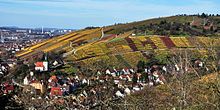
The mild city climate and the hillside locations make winegrowing possible in the middle of Stuttgart, as here in Obertürkheim.
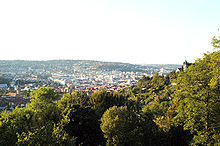
View from the Weinsteige to the Höhenpark Killesberg
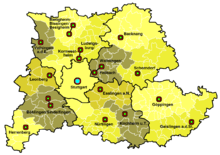
Stuttgart area
Population
Population development
→ Main article: Population development of Stuttgart and Stuttgart city statistics
See also: Demography of Germany
Stuttgart had more than 100,000 inhabitants for the first time in 1875, becoming the first major city in what is now the state of Baden-Württemberg. In 1905 the city had 250,000 inhabitants, by 1950 this number had doubled to 500,000. In 1962 the population reached its historic high of 640,560. In terms of population, the city is the sixth largest city in Germany and (after Munich and ahead of Nuremberg) the second largest city in southern Germany. In its own federal state, Stuttgart is some distance ahead of Karlsruhe and Mannheim.
The average age at the end of 2016 was 41.8 years.
According to the 2011 census, the proportion of the population with a migration background was 38.6 %. Stuttgart had the second highest proportion of all major German cities - after Frankfurt am Main with 44.2 % and ahead of Nuremberg with 36.4 %. The proportion of foreigners was 25.2 % in 2016. 44 % of Stuttgart's inhabitants had a migration background.
As of December 31, 2018, the City of Stuttgart's population register recorded 614,365 residents with primary residency and 6,926 citizens with secondary residency.
In 2018, a total of 6534 children were born (2017: 6725); this was 239 births lower than the peak in 2016. The number of births increased significantly between 2012 and 2016 and has been declining since then.
The number of annual deaths in Stuttgart has fluctuated between 5000 and 5700 for two decades, with 5507 people dying in 2017 and 5471 in 2018. The number of births exceeded the number of deaths by 1063 in 2018.
Housing situation
The average existing rent in Stuttgart is €9.92 per square metre, higher than Frankfurt am Main (€8.87) and lower than Munich (€10.22) (as at the end of 2017).
The rent level in the current rent index rose by 7.2 per cent between 2016 and 2018 to €9.60 per square metre. The average asking rent for apartments offered on the market climbed to 14.15 euros per square metre in the first half of 2018. For first-time lettings in new builds, the average asking rent was €17 per square metre, while for re-letting, the average asking rent was €13.90 per square metre.
Language
Stuttgart belongs to the Lower Swabian language area, a dialect group spoken in the central and southeastern area of Baden-Württemberg. Linguistically, Swabian belongs to the Alemannic dialects and thus to Upper German. It has separated from the other Alemannic dialects through the complete implementation of New High German diphthongization.
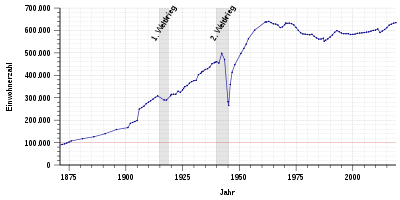
Population development of Stuttgart 1871-2018
Questions and Answers
Q: Where is Stuttgart located?
A: Stuttgart is located in Germany.
Q: What is the population of Stuttgart as of December 2011?
A: As of December 2011, the population of Stuttgart is 613,392.
Q: What is the capital of the state of Baden-Württemberg and the Administrative District of Stuttgart?
A: The capital of the state of Baden-Württemberg and the Administrative District of Stuttgart is Stuttgart.
Q: What river is Stuttgart located on?
A: Stuttgart is located on the river Neckar.
Q: How many city districts is Stuttgart divided into?
A: Stuttgart is divided into 23 city districts.
Q: What are the names of the two car manufacturers that have their headquarters in Stuttgart?
A: The two car manufacturers that have their headquarters in Stuttgart are Mercedes Benz and Porsche.
Q: What is the climate classification of Stuttgart?
A: The climate classification of Stuttgart is oceanic (Cfb in the Koeppen climate classification).
Search within the encyclopedia

